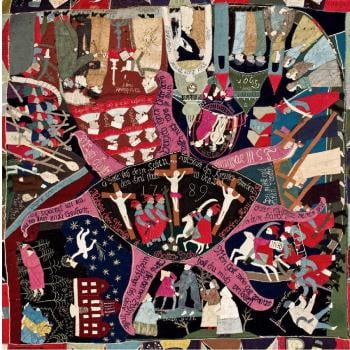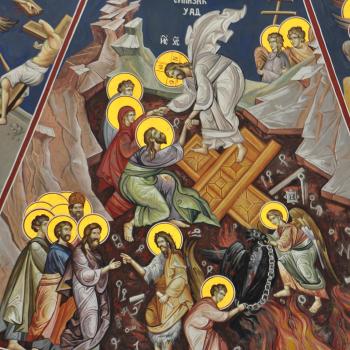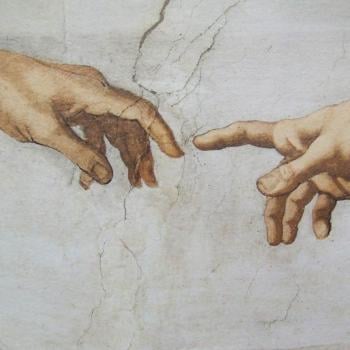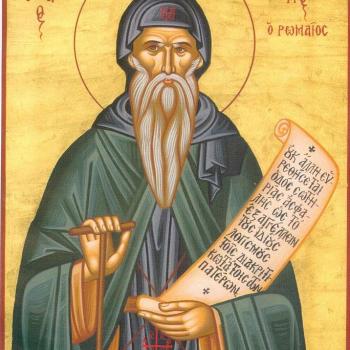![By anonimus (http://days.pravoslavie.ru/Images/im2463.htm) [Public domain], via Wikimedia Commons](https://wp-media.patheos.com/blogs/sites/637/2016/08/hymns-1-226x300.jpg)
Our discussion on the way Mary helps bring us grace should help us understand how and why she is given sometimes spoken about with the title Co-Redemptrix. This title, like her mediation which allows how to be called Mediatrix, comes from the fact that she is Theotokos, the Mother of God. She has been given a special role in salvation history, and this allows the faithful to look upon her and see the great things God has accomplished with and through her. To say she is Co-Redemptrix is not to say she did any of the work her son, Jesus, accomplished for us: she did not. Rather, to call her Co-Redemptrix indicates that she, in her cooperation with God, allowed herself to be the foundation for Christ’s humanity, so that the Logos could incarnate and save us. She worked with Christ, standing there beside him, even at the cross, helping him achieve his goals as his loving and compassionate mother. Salvation was achieved by Christ, but there she was, working with him, doing what he needed of her, raising him from infancy, feeding him, providing him all that a mother can give, without which he would not have been able to attain adulthood and minister to the world. She was his earthly companion who took care of his earthly needs so that he could take care of our heavenly ones.
And so, it must be made clear, to properly understand the title, Co-Redemptrix, it is not to be seen as indicating that Mary’s work or achievement was equal to what Jesus did for us, for how could it be, but it must be seen simply as indicating a fact about salvation history. To deny facts is dangerous to the incarnation because they end up turning it unreal, and so titles given to Mary are ways in which the reality of the incarnation are made manifest to believers. Mary worked with Jesus so that what she did, however subordinate it was to the work he did, nonetheless played an important role in the economy of salvation. [1] Just as someone who made the paper that an author used to write a book provided the means by which the author could write, and so had a share in the creation of the book, though they did not write it, so Mary had a share in what Jesus did by providing him his humanity and being with him as his loving mother whenever he needed her there. Again, it is in and through her that Jesus was born; it is her flesh and blood which was taken up and used by the Logos to form his body. “And He did not bring His body down from heaven and come through her as through a channel, but assumed from her a body consubstantial with us and subsisting in Himself.”[2] It is by her that Christ took up and assumed humanity; he did not create it ex nihilo, for if he did, he would have had that distinction which made him different from the rest of humanity. And so it is also through her that he is a descendent of David, which he needed for him to be David’s heir.
Before the incarnation, Mary had been given the choice to turn herself completely over to God and to let God do what he wanted through her, that is, give birth to the God-man. When she accepted the task given to her, she acted with God for the sake of our salvation. But she lived this giving up of herself even when Jesus gave himself over to death on the cross; she experienced it like no other because it was her son, flesh of her flesh, which suffered and died right in front of her.[3] She willingly followed God in all things, and took her place at the side of her son, Jesus, even as Eve was at the side of Adam, complementing him while never equaling his accomplishments:
From these considerations, the proof develops on these lines: if Mary, in taking an active part in the work of salvation, was, by God’s design, associated with Jesus Christ, the source of salvation itself, in a manner comparable to that in which Eve was associated with Adam, the source of death, so that it may be stated that the work of our salvation was accomplished by a kind of “recapitulation,” in which a virgin was instrumental in the salvation of the human race, just as a virgin had been closely associated with its death; if, moreover, it can likewise be stated that this glorious Lady had been chosen Mother of Christ “in order that she might become a partner in the redemption of the human race”; and if, in truth, “it was she who, free of the stain of actual and original sin, and ever most closely bound to her Son, on Golgotha offered that Son to the Eternal Father together with the complete sacrifice of her maternal rights and maternal love, like a new Eve, for all the sons of Adam, stained as they were by his lamentable fall,” then it may be legitimately concluded that as Christ, the new Adam, must be called a King not merely because He is Son of God, but also because He is our Redeemer, so, analogously, the Most Blessed Virgin is queen not only because she is Mother of God, but also because, as the new Eve, she was associated with the new Adam.[4]
Marian teachings are all about Christ her son; they show us how he relates to us through her humanity and how that humanity is called to cooperate with and work with Christ for its own salvation. We are called to work out our own salvation with much fear and trembling (cf. Phil. 2:12). This is true, not just individually, but communally as well. That communal work in Israel is what produced Mary as the heart of humanity. Through Israel, we are shown that humanity was working with God, being slowly raised up by cooperation with God’s grace, so that Jesus could be born, have his earthly ministry which ends with his death on the cross, and his final glorification in his resurrection and ascension. Mary, Jesus’s mother, was always there beside him to confirm to us he did all of this, not just as a divine person, but as man, with a real humanity which is not his alone, but shared by all of us. Jesus fulfilled in himself our common human task, and it is in and with Mary, that this was made possible. But it is only a subordinate work, for what was done could not have been done if it were not the Logos at work in and with our humanity.
More to Come
[1] The prefix “co,” means “with.” A boss is a coworker with those he manages, but he is not their equal. Indeed, as can be seen with the term “copilot,” the term often indicates subordination. This must always be kept in mind when we talk about Mary as Co-Redemptrix.
[2] St. John of Damascus, “An Exact Expositions on the Orthodox Faith” in Saint John of Damascus: Writings. trans. Fredric H. Chase, Jr. ( New York: The Catholic University of America Press, 1958), 292-3.
[3] Abraham was similarly called, and was willing to render Isaac, his son, to God, but he was stopped before Isaac was sacrificed. Jesus, the true son of Abraham, is the one true sacrifice, and so, unlike Abraham, Mary truly had to experience the rendering of God’s greatest gift to her over to death.
[4] Pope Pius XII, Ad Caeli Reginam. Vatican Translation. ¶38.
Stay in touch! Like A Little Bit of Nothing on Facebook:
A Little Bit of Nothing













